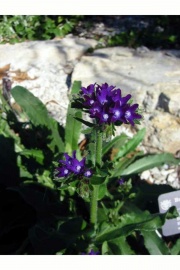Difference between revisions of "Alkanet"
(username removed) |
|||
| Line 4: | Line 4: | ||
== Description == | == Description == | ||
| − | A natural red dye obtained from the roots of two species of plants. In the near East and Europe, alkanet is extracted from the false alkanet plant, ''Anchusa officinalis'' (and ''A. tinctoria''). In Asia, alkanet is extracted from the true alkanet plant, ''Lawsonia alba''. Alkanet was used in late Egyptian times through the Middle Ages at which time its use was discontinued because of poor lightfastness. Alkanet roots produces a deep red color that is soluble in weak acids, alcohols, oils, and other organic solvents. The primary colorant is [ | + | A natural red dye obtained from the roots of two species of plants. In the near East and Europe, alkanet is extracted from the false alkanet plant, ''Anchusa officinalis'' (and ''A. tinctoria''). In Asia, alkanet is extracted from the true alkanet plant, ''Lawsonia alba''. Alkanet was used in late Egyptian times through the Middle Ages at which time its use was discontinued because of poor lightfastness. Alkanet roots produces a deep red color that is soluble in weak acids, alcohols, oils, and other organic solvents. The primary colorant is [[alkanninH|alkanninH]]. Since alkanet gives a blue tone in basic solutions, it is sometimes used as an [[indicator%20dye|acid-base indicator]]. The colorant has been used as a cosmetic, textile dye, wood stain, lake pigment, and for medicinal purposes. |
== Synonyms and Related Terms == | == Synonyms and Related Terms == | ||
Revision as of 09:52, 7 January 2014
Description
A natural red dye obtained from the roots of two species of plants. In the near East and Europe, alkanet is extracted from the false alkanet plant, Anchusa officinalis (and A. tinctoria). In Asia, alkanet is extracted from the true alkanet plant, Lawsonia alba. Alkanet was used in late Egyptian times through the Middle Ages at which time its use was discontinued because of poor lightfastness. Alkanet roots produces a deep red color that is soluble in weak acids, alcohols, oils, and other organic solvents. The primary colorant is AlkanninH. Since alkanet gives a blue tone in basic solutions, it is sometimes used as an acid-base indicator. The colorant has been used as a cosmetic, textile dye, wood stain, lake pigment, and for medicinal purposes.
Synonyms and Related Terms
Anchusa officinalis (common bugloss); Anchusa tinctoria (Dyer's bugloss); Natural Red 20; CI 75530; anchusa (Esp.); alcanna (Fr.); orcannette (Fr.); orkanette (Deut.); ancuse (It.); Boettger's paper; anchusin paper; dyer's alkanet; bugloss; violet carmine; aldanet; alkannin; orchanet; orkane
Other Properties
Alkannin is soluble in alcohols, oils and other organic solvents. Alkannin is slightly soluble in water.
Alkannin forms a deep blue solution with alkalis and a purple precipitate with bichloride of tin.
Additional Information
° J.Hofenk-de Graaf, Natural Dyestuffs: Origin, Chemical Constitution, Identification, Central Research Laboratory for Objects of Art and Science, Amsterdam, September 1969.
Authority
- R.J. Adrosko, Natural Dyes in the United States, Smithsonian Institution Press, Washington, DC, 1968
- Ralph Mayer, A Dictionary of Art Terms and Techniques, Harper and Row Publishers, New York, 1969 (also 1945 printing)
- Palmy Weigle, Ancient Dyes for Modern Weavers, Watson-Guptill Publications, New York, 1974
- F. Crace-Calvert, Dyeing and Calico Printing, Palmer & Howe, London, 1876
- J. Thornton, 'The Use of Dyes and Colored Varnishes in Wood Polychromy', Painted Wood: History and Conservation, The Getty Conservation Insitute, Los Angeles, 1998
- G.S.Brady, Materials Handbook, McGraw-Hill Book Co., New York, 1971 Comment: p. 184
- Website address 1 Comment: http://www.coloria.net/varita.htm - NR 20, 75520
- Wikipedia, the free encyclopedia, at http://www.wikipedia.com Comment: alkanet
- Art and Architecture Thesaurus Online, http://www.getty.edu/research/tools/vocabulary/aat/, J. Paul Getty Trust, Los Angeles, 2000
